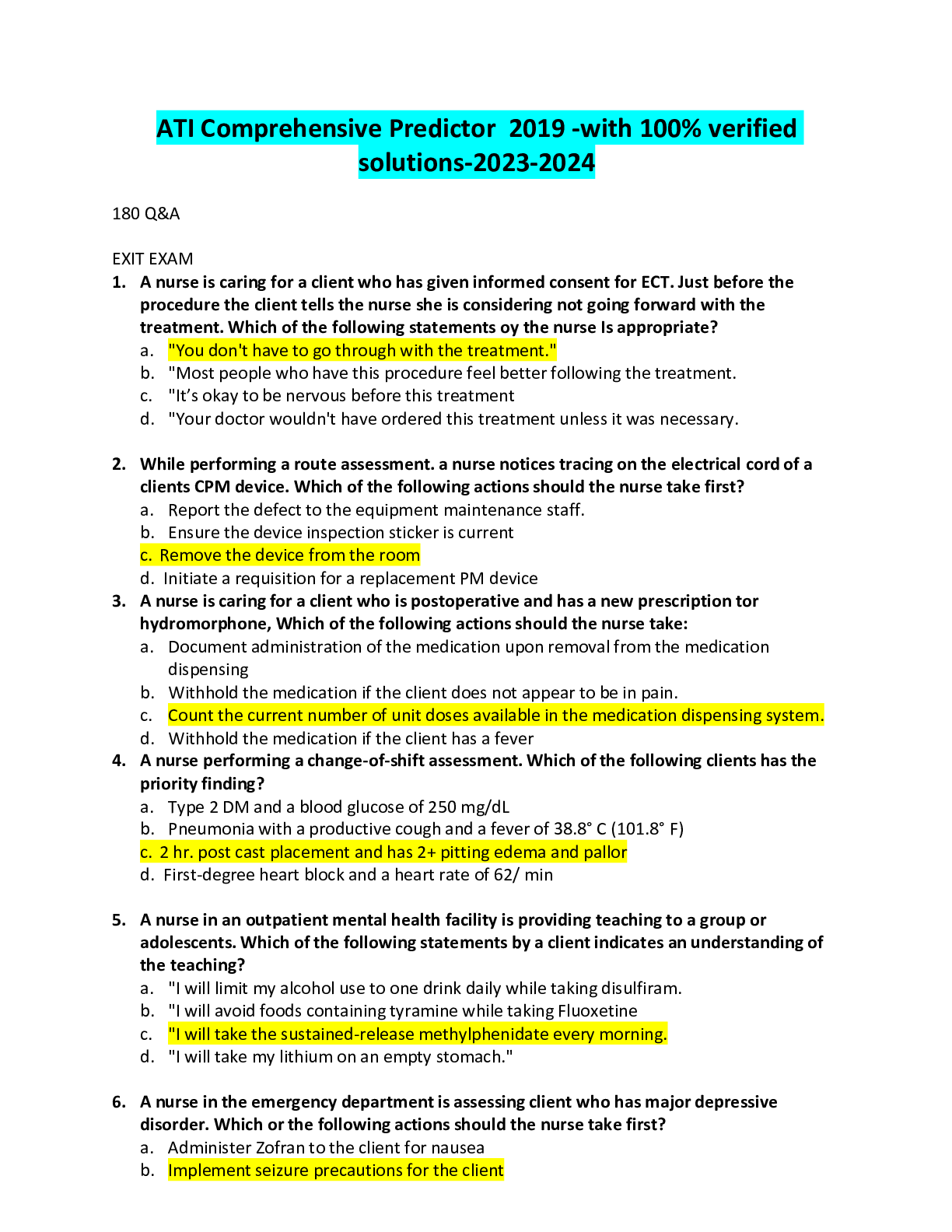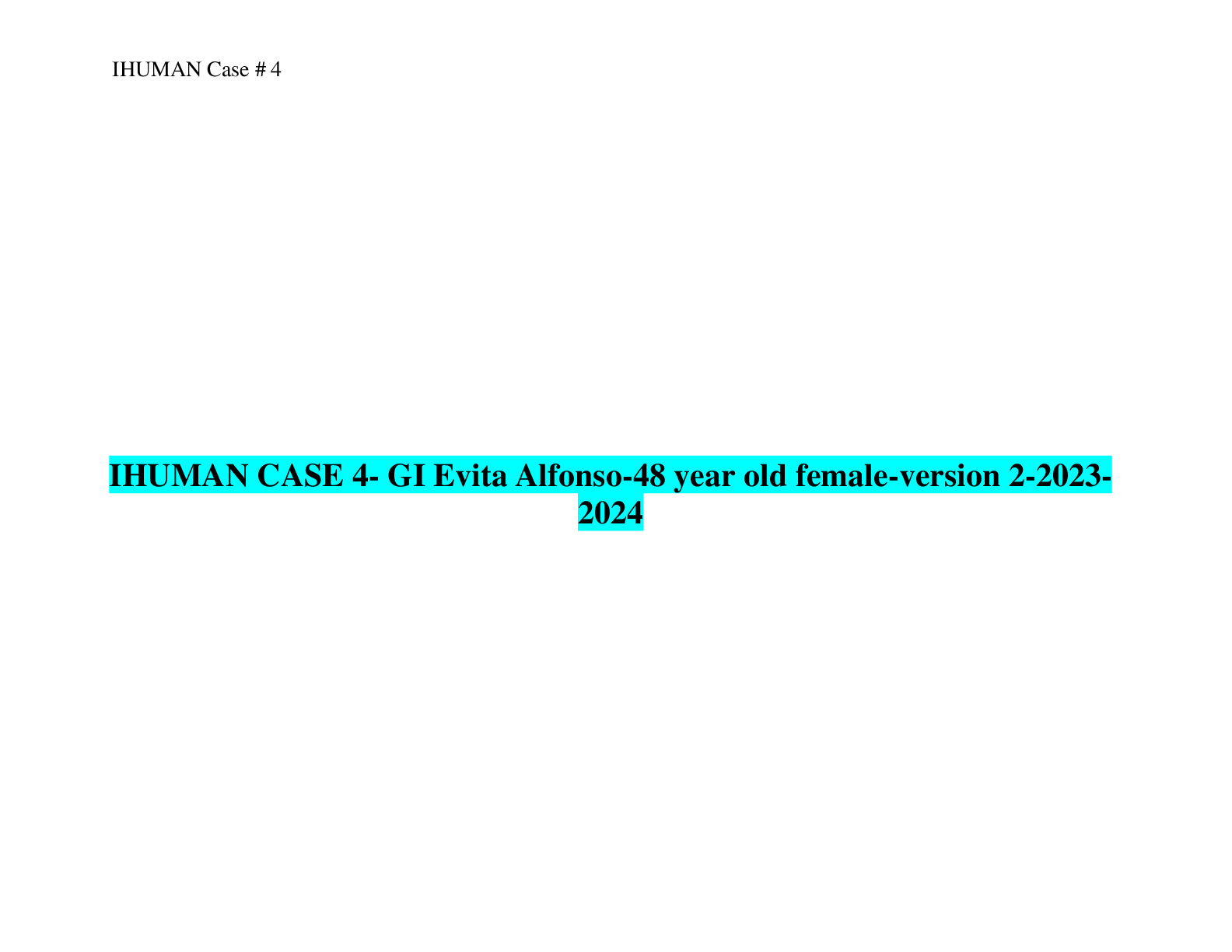NR 327 Exam 2 Content Review Sheet-2020-2021
Document Content and Description Below
1. Immediately after birth, the nurse can anticipate the fundus to be located A. at the umbilicus. B. 2 cm above the umbilicus. C. 1 cm below the umbilicus. D. midway between the symphysis pubis a... nd umbilicus. Correct Immediately after birth the uterus is about the size of a large grapefruit and the fundus can be palpated midway between the symphysis pubis and umbilicus. Within 12 hours the fundus rises to the level of the umbilicus. By the second day, the fundus starts to descend by approximately 1 cm/day. Awarded 0.0 points out of 1.0 possible points. 2. 2.ID: 18649223421 When reading the postpartum chart the nurse notices that the patient’s fundus is recorded as “u+1.” The nurse understands that this means the fundus is A. 1 cm above the umbilicus. Correct Descent of the fundus is documented in relation to the umbilicus and is measured in centimeters. Numbers with a plus sign mean that the fundus is above the umbilicus; numbers with a minus sign mean that the fundus is below the umbilicus. B. 1 cm below the umbilicus. C. 1 inch above the umbilicus. D. 1 inch below the umbilicus. Awarded 0.0 points out of 1.0 possible points. 3. 3.ID: 18649222873 During the second postpartum day, a woman asks the nurse, “Why are my afterpains so much worse this time than after the birth of my other child?” The best answer by the nurse would be: A. “Most women forget how strong the afterpains can be.” B. “They should not be strong with you because you are breastfeeding.” C. “You should not be feeling the pains now; I will notify the physician for you.” D. “Afterpains are more severe for women who have already given birth.” Correct Afterpains are more acute for multiparas because repeated stretching of muscle fibers leads to low muscle tone, which results in repeated contraction and relaxation of the uterus. Breastfeeding increases the severity of afterpains. The afterpains are self-limiting and will decrease rapidly after 48 hours. Awarded 0.0 points out of 1.0 possible points. 4. 4.ID: 18649222897 The nurse is assessing the patient’s vaginal discharge. It is red and has about a 2-inch stain on the peripad. The nurse will record this finding as a A. light amount of lochia rubra. Correct Lochia rubra is red in color and occurs the first 3 or 4 days after birth. A light amount of discharge is classified as a 1- to 4-inch stain on the peripad. B. scant amount of lochia alba. C. moderate amount of lochia rubra. D. heavy amount of lochia alba. Awarded 0.0 points out of 1.0 possible points. 5. 5.ID: 18649222891 The new mother is complaining of pain at the episiotomy site; however, because she is breastfeeding, she does not want any medication. What other alternatives can the nurse offer this mother to help relieve the pain? A. Ambulation B. Topical anesthetics Correct Topical anesthetics can be applied directly to the site to numb the area. This will not cause systemic effects like pain medications. Sitz baths may also be soothing. C. Hot fluids to drink D. Stool softeners Awarded 0.0 points out of 1.0 possible points. 6. 6.ID: 18649222875 A mother who is 3 days postpartum calls the clinic and complains of “night sweats.” She is afraid that she is going into early menopause. The nurse should base her answer on the fact that A. birth may put some women into early menopause; an appointment is needed to have this checked out. B. night sweats may be an indication of many other problems; an appointment is needed to assess the problem. C. diaphoresis is normal during the postpartum period, and comfort measures can be suggested to the mother. Correct Diaphoresis and diuresis rid the body of excess fluids that accumulated during the pregnancy. Diaphoresis is not clinically significant, but can be unsettling for the mother who is not prepared for it. Explanations of the cause and provision of comfort measures, such as showers and dry clothing, are generally sufficient. D. diaphoresis is normal only if the mother is breastfeeding. Awarded 0.0 points out of 1.0 possible points. 7. 7.ID: 18649223423 On the first postpartum day a patient’s white blood cell count is 25,000/mm3. The nurse’s next action should be to A. notify the physician for an antibiotic order. B. assess the patient’s temperature and blood pressure. C. request the count be repeated. D. note the results in the chart. Correct CONTINUED........... [Show More]
Last updated: 2 years ago
Preview 1 out of 50 pages
Buy this document to get the full access instantly
Instant Download Access after purchase
Buy NowInstant download
We Accept:

Also available in bundle (1)

NR 327 exams (different versions)
NR 327 exams (different versions) including study guides
By Studyrepository 3 years ago
$30.5
5
Reviews( 0 )
$14.00
Can't find what you want? Try our AI powered Search
Document information
Connected school, study & course
About the document
Uploaded On
Apr 11, 2022
Number of pages
50
Written in
Additional information
This document has been written for:
Uploaded
Apr 11, 2022
Downloads
0
Views
82















